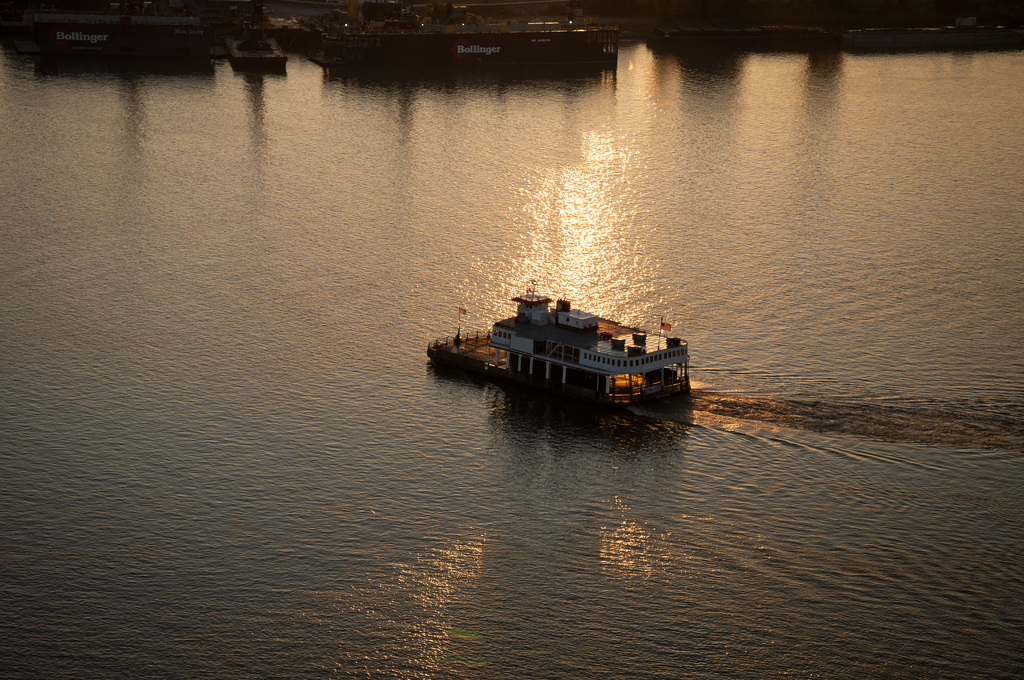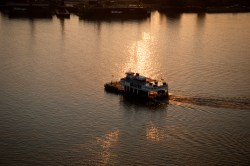Come the end of this month, New Orleans may lose its one and only ferry, thanks to a state uncommitted to keeping it financially afloat and a city even less sure about who’s responsible for keeping it from going under. This is the ferry that since 1827 has crossed the Mississippi River, transporting “West Bank” residents to jobs downtown. It’s the ferry featured in the HBO series Treme that carries the populist scold Creighton Bernette, a hopeless romantic for New Orleans, to his death at the end of the first season. Now, with its original funding stream dammed off for good, the ferry’s own ending is imminent.
Funding for public transit is pretty shallow across the nation, no matter whether we’re talking buses, rail, or otherwise. As the nonprofit Transportation for America recently reported, last year’s federal transportation bill surfaced with less funding than normal, leaving states to look for creative ways to cover yawning budget shortfalls. But ferry service gets stepchild treatment even during prosperous years.
In Louisiana — a state not historically friendly to expanding public services — transit has taken a backseat to issues like health care and coastal restoration. The endangered ferry species, meanwhile, is having a tough time getting any government agency’s attention.
Three ferries serve the greater New Orleans metropolitan region by shuttling pedestrians and cars across the Mississippi, mostly for work purposes. The one ferry that serves New Orleans city proper brings residents who live on the West Bank to the Canal Street station, which is within walking distance of thousands of hotel, restaurant, bar, retail, banking, hospital, and government jobs. The ferry carries over a million pedestrians and over 175,000 cars annually on average.
West Bank residents are predominantly African American, and many live below the poverty line. If the ferry stops or reduces service, as it’s scheduled to do on July 1, their only route across the river is by the Crescent City Bridge, which is often clogged with cars and trucks. For the many ferry riders who don’t own cars, and who would have to ride a bus instead, that would add over 10 hours to their weekly commutes (the ferry ride is just five minutes), or $200 extra in weekly cab fees, according to the public transit advocacy nonprofit Ride New Orleans.
If ferry service is interrupted, it will also affect tourists, who are a huge part of the economy here. Making up a third of ferry riders, tourists often take the reverse commute from Canal St. to Algiers, which is a somewhat quieter alternative to the often boisterously festive downtown New Orleans, which fills with crowds even on regular weekdays.
With so many jobs impacted in a city still recovering from hurricane and flood devastation, you’d think saving the ferry would be a priority for government officials. But most government agencies have done little more than float ideas around with little action. The state’s transportation department has been trying since last year to privatize the Canal St. ferry, but has found no takers. Louisiana Gov. Bobby Jindal (R), meanwhile, has been less than accommodating of mass transit. In 2009, he infamously refused almost $300 million in stimulus transportation funds, making a political statement at the expense of his state’s needs.
Up until this year, ferry operations were funded by a toll drivers paid when crossing the Crescent City Bridge. But state legislators divorced the bridge toll funding from ferry operations last year, and then voters did away with the toll for good with a referendum this spring. New legislation has since worked its way through the Louisiana House and Senate to open a treasury fund for the New Orleans ferry with $800,000 from the state. That’s enough to keep the ferry open for 20 hours a week. It currently runs 129 hours a week, open every day from 6:00 in the morning to 12:30 after midnight, at a cost of about $4 million a year.
Another idea would be to charge pedestrians to use the ferry — walkers currently ride for free, while drivers pay a dollar to take a car across. But that would still leave a funding gap of as much as $2 million.
In the meantime, it is not clear who is responsible for New Orleans’ ferry right now. When I spoke to officials with the Regional Transit Authority, which operates the city’s bus and streetcar services, I was told they “do not currently have oversight of the ferry,” and that they “have no comment to make on the ferries at this time.”
A May 9 article in The Advocate stated that “New Orleans Regional Planning Commission in February became responsible for oversight” of the Canal St. ferry and another ferry, also doomed, that serves a neighboring West Bank town called Gretna. The commission has historically managed programming funds for some ferry-related services, has conducted studies on ferry service, and is helping with finding alternative funding. But the commission is “not an operating entity,” said Jason D. Sappington, the commission’s senior transportation planner, “and will likely have no direct role in maintaining service.”
“Our interest right now is trying to ensure that the service does not lapse in the short term, and is a financially stable and useful service in the long term,” Sappington said. “To that end we’ve been meeting with local government, elected officials, and the state [transportation department] on a regular basis to try and craft a solution that will keep the boats running.”
Employers in the area the ferry serves are nervous. Jeremy DeBlieux, president of the French Quarter Business Association, wrote in a May 23 letter to his state senator and representative:
As a representative group of businesses in the French Quarter, our board of directors would like to express serious concern for our employees and their families who depend on regular ferry service for their livelihood. The ferry provides an absolutely vital connection between the East and West Bank of New Orleans, the French Quarter Business Association has a vast constituency reliant on that service.
There have been a few attempts by Congress to dedicate specialized funding for ferries. In 2003, Democrats introduced a bill that would have established a federal office to coordinate construction, maintenance, and operations for ferry boats and facilities. It would have also created a national ferry database and an institute for research and development. That bill was co-sponsored by the recently deceased Sen. Frank Lautenberg (D-N.J.), a huge proponent of public transit whose state depends heavily on ferry service to and from New York City. A similar bill was reintroduced in 2011, but like its 2003 predecessor, it languished in committee.
Last year’s federal transportation bill includes funding for construction of ferries and terminals, but David Goldberg, communications director for Transportation for America, says he doesn’t believe there are any provisions for ferry operations.
According to the American Public Transportation Association’s 2012 Fact Book, the New Orleans ferry system had the fourth highest ridership in the nation, with over 2 million trips in 2010 — bested only by two ferry systems in New York City and one in Seattle. And ferries could play a much larger role in Louisiana’s transportation needs: The state has 2,820 miles of inland waterways, the second longest in the nation.
Climate change, rising sea levels, and an overheated Gulf of Mexico make the case for water-based transportation even stronger. People who need to evacuate ahead of oncoming storms — especially those without cars — will need strong ferries. In the event of a mandatory evacuation, residents who need transportation assistance must go to one of 17 “evacuspots” across New Orleans. Two of those are on the West Bank. If carless West Bank residents are at work in the French Quarter when an evacuation is called and they need to get home to grab vitals before exiting via an evacuspot, the ferry might be the only option if buses are packed.
NOAA anticipates a heavy hurricane season this year, and one has already formed in the Gulf. New Orleans simply needs this ferry too much for it to be featured in yet another season finale.



